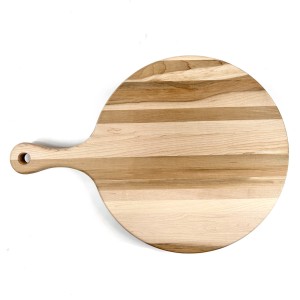Blog
The Art of the Pizza Peel
Of all the culinary tools in the world, it’s hard to rival the Pizza Peel board with handle based on its utility and craftsmanship. This simple tool spans a distance between the arts of cooking and the sciences of heat transfer. What truly makes a pizza peel with a handle remarkable then? It’s an important tool in the kitchen, due to its intricate details and craftsmanship.
Functionality and Craftsmanship
It may look like a small wooden board, but the pizza peel is literally an extension of the cook’s hand and serves the purpose o f easily moving the pizza from counter to oven. Literally speaking, the handle will prove the unsung hero by providing leverage, keeping hands safe from the oven heat.
f easily moving the pizza from counter to oven. Literally speaking, the handle will prove the unsung hero by providing leverage, keeping hands safe from the oven heat.
A well-designed pizza peel with a handle is just a marvel of design. Hardwood has to be strong yet light, resistant to high temperatures, and non-warping. The handle should be ergonomic in design, fitting comfortably in the hand, long enough to keep fingers clear of the heat, yet short enough to maneuver easily.
The Wood Matters
Wood choice is an art in and of itself. Some very popular choices, all bringing different qualities into the mix, would be maple, cherry, and walnut. Maple is a very hard wood, resistant to knife scars, and thus long-lasting. Cherry has a very beautiful reddish tint that darkens with age, adding elegance to any kitchen. Walnut has a very dark, rich color with a distinctive grain and is both durable and strikingly beautiful.
Each type of wood conveys a different feel to the pizza peel, one affecting not just its look but its balance and weight. Properly balanced with the right weight distribution, all of a difference is placed upon whether it’s a smooth transfer or a dropped pizza. The feel of a peel, well-made of fine woods, lends to a truly tactile experience of holding and manipulating it, enhancing the overall cooking experience.
The Craft of the Handle
Long with the handle comes a lot of craft. It should be accurately shaped and sanded smooth; at other times, it is treated with food-safe oils to bring out the beauty of the wood while preserving it. In designing the handle, one considers the aesthetics and functionality with enough comfort in the grip and allowance of the overall look of the peel.
As much as a fine handle is an extension of the arm, it provides all sorts of deft and sure movements. Weight and balance are important in a peel. Too heavy, it drags; too light, it can’t be used forcefully enough. The length of the handle will also make a difference for its use. The longer the handle, the better the leverage, keeping hands farther from the heat of the oven, and more in control and precise it is.
Historical Significance
In a way, the history of the pizza peel is concurrent with the history of pizza. For hundreds of years, one piece of equipment was required to move pizzas in and out of the intense heat in traditional wood-fired ovens used in Italy. So it’s something that was born of necessity but turned into a symbol of culinary heritage. Every region in Italy—or any country, for that matter—has variations and preferences passed down from generations directly reflecting the local materials and traditions concerning cuisine.
The pizza peel stands as a window to the past in so many ways, speaking to ancient methods of cooking passed down from generation to generation. This well-crafted pizza peel will link that modern cook to all these rich traditions, adding authenticity to the act of making pizza.
Beyond the Kitchen
A handled pizza peel is not just a tool but even a piece of craftsmanship. It speaks of care and attention, and reminds that the simplest tool may be made special through considered design and accomplished workmanship. A lot of aesthetic elements that are combined in a finely crafted pizza peel will add up to become a piece that creates a statement in any kitchen—adding to its ambiance and making cookware a delight.
In this age, when convenience seems to be king most of the time, the pizza peel is going to stand its ground as a testament to the enduring value that a well-made tool brings. It’s a nod to tradition—a sort of celebration of handmade and a reminder that in the kitchen, much like in life, it is in the details where one finds the difference. Getting a high-quality pizza peel might change the cooking process into something smoother and more enjoyable, ending up with better pizzas.
The Satisfaction of Hand-Hewn Tools
The joy one derives from using a handmade tool is special in its way. It contains the spirit of the artisan, the minutest imperfections that narrate its making process. No two pizza peels are alike; it speaks for itself about the individuality of the craftsman behind its making. This makes the tool even more memorable to be in the kitchen.
Handmade pizza peels are made by selecting the finest wood, carefully shaping and sanding it, and finishing them to perfection. With this kind of attention to detail and dedication to excellence, each peel can turn out to be not just a serving tool but an art form. This level of detail and passion for quality differentiates handmade tools from mass-produced ones.
Writing on pizza peels has been valuable in teaching me how to find fascination and complexity even in something as ostensibly simple as a board made out of wood. The way that crafting, material choice, and regard for detail come together in creating a tool not only useful but a delight to use—it is a lesson in the beauty of simplicity and the power of crafting.
In the end, an handled pizza peel is much more than just a tool in the kitchen: it serves to join past and present together into a form of art that elevates what everyday cooking feels like. And for that alone, it’s worth celebrating. A pizza peel connects us with a real culinary heritage, gives refinement to our kitchens, and changes pizza-making into a more pleasurable and rewarding experience. It speaks to the fact that even in a world with high technology and convenience, there is so much yet to be learned from, and appreciated about, simple, well-crafted tools of yesteryear.
